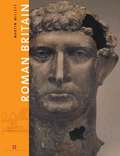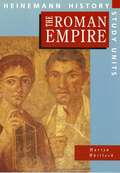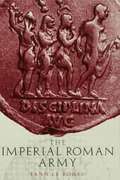Special Collections
Romans (rotten or not!)
Description: Images and books to support project and theme based learning on Roman history.
- Table View
- List View
Map of the Roman Empire (large print)
by RnibThis map shows the extent of the Roman Empire at this time. It is surrounded by an image border, and the countries have been marked by abbreviated letters. These can be referenced in the key that runs along the bottom of the page. There is a locator dot shown, which will be at the top left of the page when the image is the right way up. In the top right corner of the page there is a north arrow. Within the image border the un-textured areas represent the sea. The Roman Empire dominates countries around the centre of the map and surrounds the Mediterranean Sea. The Roman Empire itself was surrounded by other lands, which include Europe across the top section of the image and North Africa along the bottom section.
English Heritage
by Martin MillettAfter the invasion in AD 43 by the Emperor Claudius, the Romans occupied Britain for four centuries - but what exactly did this 'occupation' mean to the island's inhabitants? In this classic work - widely recommended on reading lists everywhere - eminent archaeologist Martin Millett examines the latest archaeological and historical sources to help us to understand the cultural, social and economic effects of 400 years of Roman rule. Using over 100 photographs, plans and drawings, many never published together before, Professor Millet breaks away from the traditional historical narrative to explore the central themes of life in Roman Britain.
Thinking History
by Simon MasonThis text is written for 11-13 year-olds who want to discover Roman history for themselves. Above all, it aims to make history fun.;Each chapter contains an real-life activity, designed to encourge children to look closely at the evidence provided from which they can build up their own picture of the past. They are challenged for example to take on the role of a Roman architect who's brief is to plan a Roman town. What can they tell from the archaeological remains of real Roman towns? What evidence is available from written observations of visitors to Roman towns? How can chidren get to grips with the technology of Roman buildings?
Roman road - cross section (UEB Uncontracted)
by Rnib BookshareAn image border surrounds this image of a cross section of a Roman road, with a key explaining what the different lines represent, at the bottom of the page. There is a locator dot shown, which will be at the top left of the page when the image is the right way up. On the far left and far right side of the page, normal ground soil is shown, and in the centre of the image, four horizontal layers of material which make up the road. On the left and right side of the top layer are drainage ditches, which the water run-off from the road would drain into.
Roman road - cross section (Large Print)
by Rnib BookshareAn image border surrounds this image of a cross section of a Roman road, with a key explaining what the different lines represent, at the bottom of the page. There is a locator dot shown, which will be at the top left of the page when the image is the right way up. On the far left and far right side of the page, normal ground soil is shown, and in the centre of the image, four horizontal layers of material which make up the road. On the left and right side of the top layer are drainage ditches, which the water run-off from the road would drain into.
Roman Chariot and horse (UEB Contracted)
by Rnib BookshareThis image shows a side view of a horse harnessed to a chariot, which is being driven by a charioteer. The horse is on the right side of the page, with the chariot and charioteer on the left. There is a locator dot shown, which will be at the top left of the page when the image is the right way up. The horse is facing towards the right so only one ear, eye and nostril can be found. Its mouth is open and around its face it wears a bridle. Along the top of the horse's neck is its mane. At the base of the horse's neck, around its shoulders, is part of the harness of the chariot and the shaft which attaches to the chariot. Moving up from the shaft is the horse's body and tail, and moving down from the shaft are the horse's legs. This horse is trotting and is attached to the base of the chariot by the shaft to the left. In the bottom left of the image, one of the chariot's two wheels can be found. Up from this is the charioteer. He is heavily armoured. He holds both of his arms out in front of him towards the right and in his hand nearest the chariot he holds the horse's reins. These lead to the horses bridle. The charioteer's other hand is waving a whip. To the left is the charioteer's head, looking to the right, so only one eye can be found. He wears a metal helmet with decorative feathers along the top.
Roman road - cross section (UEB Contracted)
by Rnib BookshareAn image border surrounds this image of a cross section of a Roman road, with a key explaining what the different lines represent, at the bottom of the page. There is a locator dot shown, which will be at the top left of the page when the image is the right way up. On the far left and far right side of the page, normal ground soil is shown, and in the centre of the image, four horizontal layers of material which make up the road. On the left and right side of the top layer are drainage ditches, which the water run-off from the road would drain into.
Roman Chariot and horse (UEB Uncontracted)
by Rnib BookshareThis image shows a side view of a horse harnessed to a chariot, which is being driven by a charioteer. The horse is on the right side of the page, with the chariot and charioteer on the left. There is a locator dot shown, which will be at the top left of the page when the image is the right way up. The horse is facing towards the right so only one ear, eye and nostril can be found. Its mouth is open and around its face it wears a bridle. Along the top of the horse's neck is its mane. At the base of the horse's neck, around its shoulders, is part of the harness of the chariot and the shaft which attaches to the chariot. Moving up from the shaft is the horse's body and tail, and moving down from the shaft are the horse's legs. This horse is trotting and is attached to the base of the chariot by the shaft to the left. In the bottom left of the image, one of the chariot's two wheels can be found. Up from this is the charioteer. He is heavily armoured. He holds both of his arms out in front of him towards the right and in his hand nearest the chariot he holds the horse's reins. These lead to the horses bridle. The charioteer's other hand is waving a whip. To the left is the charioteer's head, looking to the right, so only one eye can be found. He wears a metal helmet with decorative feathers along the top.
Roman Chariot and horse (Large Print)
by Rnib BookshareThis image shows a side view of a horse harnessed to a chariot, which is being driven by a charioteer. The horse is on the right side of the page, with the chariot and charioteer on the left. There is a locator dot shown, which will be at the top left of the page when the image is the right way up. The horse is facing towards the right so only one ear, eye and nostril can be found. Its mouth is open and around its face it wears a bridle. Along the top of the horse's neck is its mane. At the base of the horse's neck, around its shoulders, is part of the harness of the chariot and the shaft which attaches to the chariot. Moving up from the shaft is the horse's body and tail, and moving down from the shaft are the horse's legs. This horse is trotting and is attached to the base of the chariot by the shaft to the left. In the bottom left of the image, one of the chariot's two wheels can be found. Up from this is the charioteer. He is heavily armoured. He holds both of his arms out in front of him towards the right and in his hand nearest the chariot he holds the horse's reins. These lead to the horses bridle. The charioteer's other hand is waving a whip. To the left is the charioteer's head, looking to the right, so only one eye can be found. He wears a metal helmet with decorative feathers along the top.
Roman Foot Soldier and Officer (UEB Contracted)
by Rnib BookshareThis image shows a Roman foot soldier on the left of the page and an officer on the right. Both of them are standing facing you. There is a locator dot shown, which will be at the top left of the page when the image is the right way up. In the top left corner of the page the foot soldier wears a metal helmet. He has a smiling face. Moving down, he wears some light armour over a tunic. In his hand on the left side of the page he holds a very long spear, with the sharp spearhead at the top. His sword hangs to the left of his body from his waist. His hand on his right is obscured by an oval shield. His tunic reaches his knees and he wears strapped leather sandals on his feet. The officer stands on the right side of the page. In the top right corner is the officer's helmet, with a large feather plume on top. He also has a smiling face. Down the page he wears a metal breastplate and to the left of this his shoulder is draped with a cloak. His arm hangs by his side. His sword also hangs to the left of his body. On his other side his hand is obscured, as he is holding a very large shield. He also has a knee length tunic, but in addition he wears protective shin armour on his legs. Like the foot soldier, he wears leather sandals on his feet.
The Roman Empire
by Martyn WhittockFocusing on the Roman Empire, this is one of a history series which offers teachers the flexibility to design their own scheme of work at Key Stage 3 of the National Curriculum.
Thinking History
by Simon MasonThis text is written for 11-13 year-olds who want to discover Roman history for themselves. Above all, it aims to make history fun.;Each chapter contains an real-life activity, designed to encourge children to look closely at the evidence provided from which they can build up their own picture of the past. They are challenged for example to take on the role of a Roman architect who's brief is to plan a Roman town. What can they tell from the archaeological remains of real Roman towns? What evidence is available from written observations of visitors to Roman towns? How can chidren get to grips with the technology of Roman buildings?
Roman Hypocaust system (UEB Contracted)
byThere are two images on this page, a cross section view at the top and a plan at the bottom of the page. They are both surrounded by an image border. There is a locator dot shown, which will be at the top left when the images are the correct way up.The cross section - shows the lower walls of a room at the top of the image and the underfloor area at the bottom. There is part of a furnace on the left of the image with an arched roof. Right from it is a duct (small tunnel) through the wall which allows the hot air to circulate under the floor around the support pillars and into the wall spaces. There is part of a wall above the duct and another on the right of the image. The plan also shows the furnace on the left of the image with part of the foundations of its wall surrounding it. To the right are the ducts through to the underfloor area. The foundations of the walls can be found to the right of the furnace and on the right of the image. Each wall has a ducts allowing hot air into the wall space. Between the walls is a grid of the supporting pillars.
Roman Numerals (large print)
by RnibThis image shows Roman numerals 1 to 10 and numbers 1, 5, 10, 50, 100, 500, 1000. It also shows 2014 as a Roman numeral.
Roman Numerals (UEB contracted)
by RnibThis image shows Roman numerals 1 to 10 and numbers 1, 5, 10, 50, 100, 500, 1000. It also shows 2014 as a Roman numeral.
Roman Numerals (UEB uncontracted)
by RnibThis image shows Roman numerals 1 to 10 and numbers 1, 5, 10, 50, 100, 500, 1000. It also shows 2014 as a Roman numeral.
Roman Town plan (tactile)
by RnibThis is a street plan of a typical roman town. There is a scale in the top right of the image.
Imperial Roman Army
by Yann Le BohecNow available in paperback, The Imperial Roman Army looks at the structure and development of the army between the Republic and the Late Empire, examining why the army has always been accorded such a prominent position in the history of the Roman Empire, and whether that view is justified. The book is divided into three sections. The author first examines the major divisions of army organization, the legions, the auxiliary units, the fleet and how the men were recruited. Secondly he looks at what the army did, their training, tactics and strategy. Finally he considers the historical role of the army and how it fitted into Roman society.
Imperial Roman Army (PDF)
by Yann Le BohecNow available in paperback, The Imperial Roman Army looks at the structure and development of the army between the Republic and the Late Empire, examining why the army has always been accorded such a prominent position in the history of the Roman Empire, and whether that view is justified. The book is divided into three sections. The author first examines the major divisions of army organization, the legions, the auxiliary units, the fleet and how the men were recruited. Secondly he looks at what the army did, their training, tactics and strategy. Finally he considers the historical role of the army and how it fitted into Roman society.
Roman citizens (Large Print)
by Rnib BookshareThis image shows male and female Roman citizens who wear similar clothing. Both of them are shown standing facing you. The man is on the left of the page and the woman on the right. There is a locator dot shown, which will be at the top left of the page when the image is the right way up. In the top left of the page is the man's head. He has short hair and stands smiling. Both of his arms can be found; his arm on the left side of the page hangs by his side and on the right he holds his other arm up high as if waving. He has a signet ring on this hand. He wears a tunic with a toga wrapping over his shoulders and around his body. He also wears leather sandals on his feet. On the top right of the page is the woman's head. Her hair is tied up in a bun, and she has a smiling face. A beaded necklace decorates her neck. Her arm to the left is held out to the side and her arm to the right is held out at an angle, showing her bangle. Her palla wraps over her shoulders and drapes around her stola, held in place by a brooch. Her stola is long and reaches her ankles. On her feet she wears leather sandals.
Roman Soldier (Tactile)
by Roman SoldierThis page shows a tactile image of a Roman soldier. He is seen from the front with his arms by his side and has a short sword to his left.



